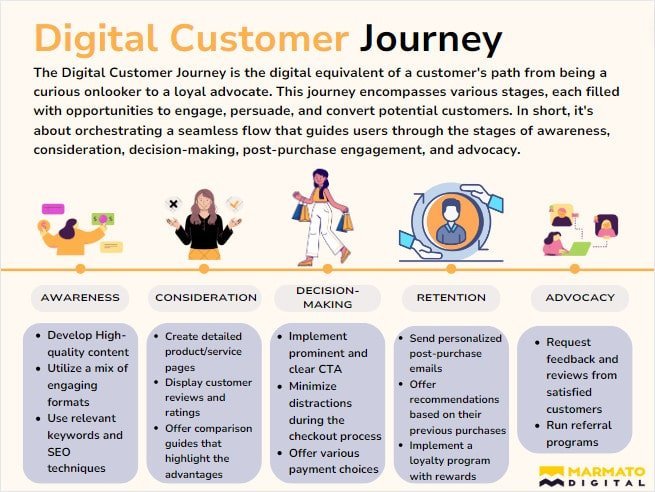In the dynamic landscape of digital marketing, transforming mere clicks into meaningful conversions is the cornerstone of success for businesses of all sizes. This transformation, however, isn’t a simple process of chance. Instead, it’s a carefully planned journey known as the Digital Customer Journey. In this article, we’ll dive into the essence of the Digital Customer Journey. Additionally, we’ll explore the art of Digital Customer Journey mapping and unravel digital customer journey optimization strategies that can turn this journey into a conduit of success for your business.

Understanding the Digital Customer Journey
The Digital Customer Journey is the digital equivalent of a customer’s path from being a curious onlooker to a loyal advocate. Also, this journey encompasses various stages, each filled with opportunities to engage, persuade, and convert potential customers. In short, it’s about orchestrating a seamless flow that guides users through the stages of awareness, consideration, decision-making, post-purchase engagement, and advocacy.
Role of Digital Customer Journey Mapping
Digital Customer Journey mapping is like crafting a digital roadmap. It’s all about outlining every step and connection a customer could experience with your brand. This process grants you priceless insights into customer behaviors, likes, and pain points. As a result, you will understand how to customize your approaches and encounters to achieve the best possible outcomes. Moreover, this strategic mapping leads to a comprehensive understanding of your customers, allowing you to create tailored strategies that truly resonate.
Navigating the Digital Customer Journey Stages

Stage 1 - Awareness:
Awareness stage is the ignition point where potential customers discover your brand, product, or service. It could be through a social media post, search engine query, online ads, or shared content. To optimize this stage, create engaging and relevant content that captures attention and stimulates curiosity.
Stage 2 - Consideration:
As users’ journey into the consideration stage, they delve deeper. They research, compare, and evaluate your offerings against others. Here, by optimizing your digital journey and offering detailed information about your products or services, you can help your customers make informed decisions. To optimize this stage, provide comprehensive product information, showcase social proof, and highlight unique selling points.
Stage 3 - Decision:
Customers are ready to purchase or take a specific action in the decision stage. And this is where you need to ensure a seamless user experience. Similarly, clear calls-to-action, simplified checkout processes, and secure payment options are vital for optimization.
Stage 4 - Retention:
After the conversion, the focus shifts to retention. It’s crucial to continue delivering value and engaging with customers even after the transaction. Primarily, post-purchase engagement involves nurturing the customer relationship. Besides, utilizing digital journeys for personalized post-purchase communication, loyalty programs, and exceptional customer support plays a significant role here.
Stage 5 - Advocacy:
In the final phase, your delighted customers become your brand advocates. And they share their positive experiences with others, leading to word-of-mouth marketing. Leverage “Digital Customer Journey mapping” to continuously refine this cycle, ensuring the journey remains enticing for new and existing customers. Finally, to optimize this stage, encourage reviews, testimonials, and user-generated content highlighting their satisfaction.
Use Case: Digital Customer Journey
Certainly! Let’s consider an e-commerce use case to illustrate the five stages of the digital customer journey: Awareness, Consideration, Decision, Retention, and Advocacy. In this scenario, we’ll use a fictional online clothing store called “FashionHub.”
1. Awareness Stage:
Description:
Jane, a fashion enthusiast, becomes aware of FashionHub through a sponsored social media post showcasing trendy outfit.
Actions:
Jane clicks on the post, visits FashionHub’s Instagram profile, and explores posts showcasing various clothing styles.
Objective:
Create brand awareness and spark Jane’s interest in FashionHub’s fashion offerings.
2. Consideration Stage:
Description:
Jane continues her journey by visiting FashionHub’s website to explore their collection in detail.
Actions:
Jane browses different categories, reads product descriptions, and compares prices and styles.
Objective:
Help Jane make an informed decision by providing comprehensive information and a user-friendly browsing experience.
3. Decision Stage:
Description:
Jane has narrowed down her choices and is ready to make a purchase.
Actions:
She selects a dress, adds it to her cart, and proceeds to the checkout page.
Objective:
Simplify the purchasing process with a clear CTA and a streamlined checkout process.
4. Retention Stage:
Description:
After receiving her order, Jane receives an email from FashionHub thanking her for the purchase. In addition, offer a discount on her next order.
Actions:
Jane is delighted with her dress and signs up for FashionHub’s newsletter to stay updated on new arrivals.
Objective:
Enhance post-purchase engagement and encourage repeat business through personalized communication.
5. Advocacy Stage:
Description:
Jane shares her positive experience on her social media accounts, posting a photo of herself wearing the dress and tagging FashionHub.
Actions:
Jane’s friends and followers notice her post, inquire about the dress, and express interest in trying out FashionHub.
Objective:
Harness the power of word-of-mouth marketing as Jane becomes an advocate, driving new customers to FashionHub.
Overall Objective:
Transforming Jane from an intrigued social media user to a satisfied customer who not only makes a purchase but also becomes an advocate, spreading the word about FashionHub’s products and services.
Digital Customer Journey Optimization Strategies:
Now that we’ve laid out the stages, let’s delve into strategies for digital customer journey optimization at each stage. Moreover, by understanding and harnessing these strategies, businesses can create a pathway that leads to conversions and customer loyalty.
Following are the digital customer journey optimization strategies you could implement to guide potential customers toward becoming loyal advocates for your brand.
• Awareness: Crafting Compelling Content
– Develop high-quality content that resonates with the pain points of your target audience.
– Utilize a mix of engaging formats such as blog posts, videos, infographics, and social media posts.
– Use relevant keywords and SEO techniques to enhance visibility in search results.
• Consideration: Providing In-Depth Information
– Create detailed product/service pages with clear descriptions, images, and specifications.
– Displaying customer reviews and ratings establishes a sense of trustworthiness and credibility.
– Offer comparison guides that highlight the advantages of your offerings over competitors.
• Decision: Simplifying the Path to Conversion
– Implement prominent and clear calls-to-action (CTAs) on product pages.
– Minimize distractions during the checkout process to reduce cart abandonment.
– Offer various payment choices while guaranteeing a secure payment gateway.
• Retention: Continuing the Value
– Send personalized post-purchase emails with order confirmations and delivery details.
– Offer recommendations based on their previous purchases to keep them engaged.
– Implement a loyalty program with rewards, discounts, or exclusive offers.
• Advocacy: Encouraging Word-of-Mouth Marketing
– Request feedback and reviews from satisfied customers after a successful purchase.
– Showcase user-generated content on your website and social media platforms.
– Run referral programs that reward customers for bringing in new business.
Power of Testing and Iteration:
In the first place, remember that optimization is an ongoing process. Regularly analyze data and gather insights to understand what’s working and what needs improvement. Moreover, A/B testing can be immensely valuable in refining your strategies. In addition, experiment with different CTAs, landing page designs, and messaging to determine what resonates best with your audience.
Conclusion:
In conclusion, the digital customer journey is a roadmap that leads from initial clicks to valuable conversions. Moreover, by understanding each stage and implementing digital customer journey optimization strategies tailored to your audience, you can guide potential customers toward becoming loyal advocates for your brand. Equally important, the key lies in crafting a seamless, engaging, and value-driven experience that leaves a lasting impression. So, embrace the journey and watch your clicks transform into conversions that drive your business forward.
Convert your Leads to Customers!
At Marmato Digital, we specialize in optimizing every stage of the journey, transforming clicks into meaningful conversions. Our expert team supports enhancing your brand’s online presence, driving engagement, and fostering customer loyalty.
Let us guide you through the intricacies of optimizing your digital customer journey for success – from clicks to conversions. Contact Us today to embark on a transformative journey toward business success.
Subscribe to blogs
Get our latest blogs directly to your inbox.

